On April 15, more than 1,100 people streamed into a sunlit atrium flanked with palm trees for a Women in CyberSecurity networking event: WiCyS Virtual 20. Moderators roamed the halls, guiding visitors to their destinations — an auditorium for keynote presentations, the networking lounge where attendees could mingle with their peers in cybersecurity, or the exhibition hall where they could visit company booths.
It was everything that you’ve come to expect from a conference, except that it was all virtual.
Like thousands of other event organizers, Women in CyberSecurity (WiCyS) had initially planned for an in-person event until the spread of COVID-19 made gathering in large crowds too dangerous, said the group’s executive director, Lynn Dohm. While she considered canceling, an outpouring of support from the cybersecurity organization’s members encouraged her to see what virtual events had to offer.
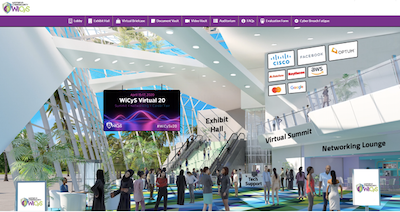
During a feverish three-week sprint, Dohm and a team of 26 volunteers worked with the virtual event platform vFairs to put together eight social gatherings, seven keynotes and 22 presentations over a three-day virtual conference. The results surprised everyone involved.
“People never expected the networking to be so robust; they never expected that in-person feeling,” Dohm said. “We had some people say it was like being at a real conference, except your feet aren’t sore and you’re not exhausted at the end of the night.”
Tips For Hosting a Virtual Conference
- Have a consistent theme throughout the conference
- Include interactive activities
- Rehearse, rehearse, rehearse
- Provide a variety of content and graphics
- Create engagement opportunities and networking events for participants
- Schedule events strategically and think about time zones
Dohm’s experience coincided with a shift in the events landscape. It may be hard to remember, but pre-COVID-19, virtual events were a rarity. Marketers feared it would cannibalize in-person attendance, and most people associated virtual events with yawn-inducing webinars.
“Even when everything gets back to normal, there’s going to be a lot of people who aren’t going to feel comfortable going to Vegas or Orlando with 10,000 other people.”
But the three months since March have changed that. Salesforce turned its World Tour Sydney into a virtual event and is planning to make Dreamforce virtual as well. In Hong Kong, Alibaba also made its conference virtual. The same holds true with organizations like WiCyS.
Ben Chodor, president of the communications company Intrado Digital Media, which offers a virtual event platform, said the company saw 4,000 inbound leads in March and similar numbers in April for virtual events. People weren’t just planning for this year but for events in 2021 and 2022.
“Even when everything gets back to normal, there’s going to be a lot of people who aren’t going to feel comfortable going to Vegas or Orlando with 10,000 other people,” Chodor said. “So you better embrace virtual now, because it is here to stay.”
Event management platform Bizzabo experienced a similar jump in virtual event interest. After thousands of companies canceled their in-person events in March, the company saw a flood of interest for virtual events, according to Alon Alroy, Bizzabo’s chief of customers and strategy.
In mid-April, the company surveyed 400 event marketers and found that 87 percent of major event organizers are running a virtual event in 2020. In addition, 90 percent of respondents are planning to invest in virtual events for the future. But the biggest question among those same organizers remains, how do you keep people engaged at a virtual conference?
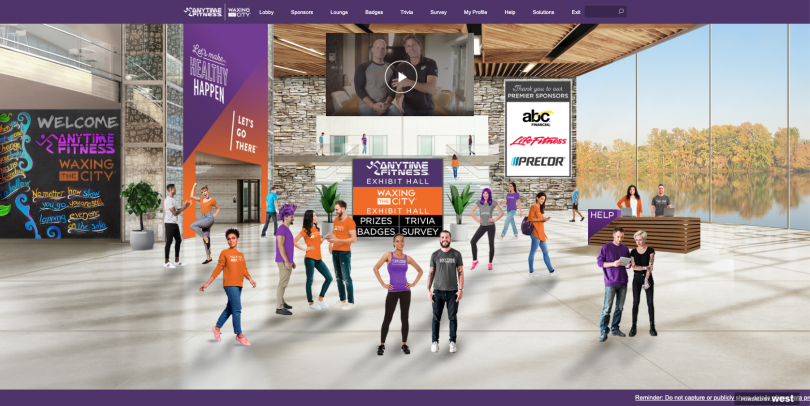
Provide a Variety of Content and Graphics
Virtual events require just as much planning as in-person ones. Sure, organizers don’t need to worry about booking a venue, hiring photographers or catering food, but if the content and graphics aren’t coherent and engaging, the exit is only a click away, Chodor said.
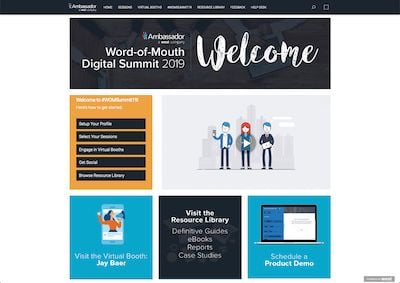
Virtual event platforms like Intrado Digital Media can do part of the work. In a lot of ways, they play the role of the conference venue, providing the framework for organizers to fill and customize for their event. At Intrado Digital Media, event organizers can choose a 3D atrium, which mimics the experience a person would actually have in a conference — minus the foot-ache of walking a quarter mile from venue to venue — or they can select the 2D venue, which lays out the events in a menu, like shows on Hulu.
However, it’s on the organizer to fill that with engaging content and graphics, Chodor said.
“If you don’t have good content, no one is going to come, and if you don’t have good people there, no one’s going to really love it afterward,” Chodor said. “That being said, you still have to make it aesthetically pleasing.
When it comes to planning graphics for the event, Chodor recommends organizers think about setting the tone for the experience they want visitors to have. There’s a reason that Dohm chose palm trees and sunny skies for WiCyS’s networking event. Same with the fact that the avatars in the virtual conference space were 90 percent women, and that attendees were encouraged to keep their video on in chats.
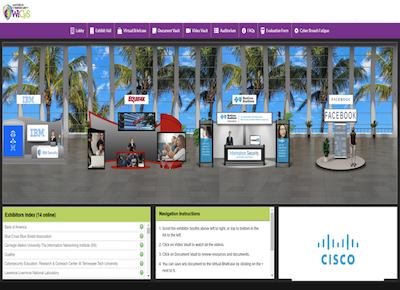
Those background details set the tone for the event.
“We did that intentionally because we wanted to give it a nice, airy, fresh feeling, and one of brightness and hope,” Dohm said. “We wanted to make it extremely joyful.”
From there, it’s important to give people a variety of content, just like an in-person conference would. The best virtual conferences give people the option to attend TED-style talks, participate in Q&As, hang out in breakout rooms or attend yoga or meditation seminars, Chodor said. During Intrado Digital Media’s virtual corporate all-hands gathering, the company had trivia, Jeopardy! and a session where executives read “mean Tweets” from employees, as if they were celebrities on Jimmy Kimmel.
“If you don’t have good content, no one is going to come, and if you don’t have good people there, no one’s going to really love it afterward.”
Since people are used to multitasking on their computers, give them the ability to chat during a webinar or engage with other related content at the same time, added Alroy. Meanwhile, any sessions attendees miss can then be uploaded to the website for them to engage with on their own time.
Chodor suggests having a moderator on hand to provide regular updates, interview speakers and summarize events in the style of a news broadcast to unify everyone and catch them up on what they missed.
But people need more than interesting speakers and graphics to stay glued to their computer screens all day — they need to be able to engage with the content.
Create Opportunities to Engage With the Content — and Attendees
At any moment during the WiCyS conference, its networking lounge had about 150 people mingling about, connecting with each other. Thought bubbles would pop up with people asking for advice, while others would share their LinkedIn profiles or form small chat groups.
Attendees in a video presentation participated in a Q&A with the speaker and then took the conversation to Twitter using the hashtag #WiCySV20. All told, the event had eight million total impressions across Twitter and Instagram, according to Dohm.
It was almost as lively as its in-person events, she said.
“Even people who might have been apprehensive about a virtual event previously realized this was the only way to get the knowledge and share this information, so it launched them into the virtual networking space too,” Dohm said. “It opened up a lot of doors for a lot of people.”
Since people can’t bump into each other randomly at booths like they can in person, it’s important to provide other avenues of engagement, Chodor said. Virtual events need to create those opportunities through networking rooms, exhibitor booths and breakout rooms. With no limitation on space, networking rooms can even be divided into specific groups based on jobs or preferences.
“Even people who might have been apprehensive about a virtual event previously realized this was the only way to get the knowledge and share this information, so it launched them into the virtual networking space too.”
But the way people engage with those rooms needs to be different. Some ways to do that can include giving people the ability to initiate conversations with the hosts and shape their own experiences.
“When I go to a trade-show booth, I still want to talk to someone in a virtual event,” Chodor said. “I want to control the conversation and ask questions. One of the best parts of virtual events is that it puts a lot more power on attendees to get the information they want.”
Beyond social interaction, another way to keep people’s attention is to incorporate games, social media, data and polling. This is where virtual events can really shine, Chodor said. During keynotes, event organizers can arrange surveys in-sync with the presentation for streamers to engage with and see the results in real time. In between events, they can visit booths and rooms to earn badges and rewards for participation.
No matter how serious the conference, it needs to be entertaining, Chodor said.
“It’s not a Netflix show you’re binge-watching,” Chodor said. “You have to do polling, and surveys and things to keep the attention of your audience.”
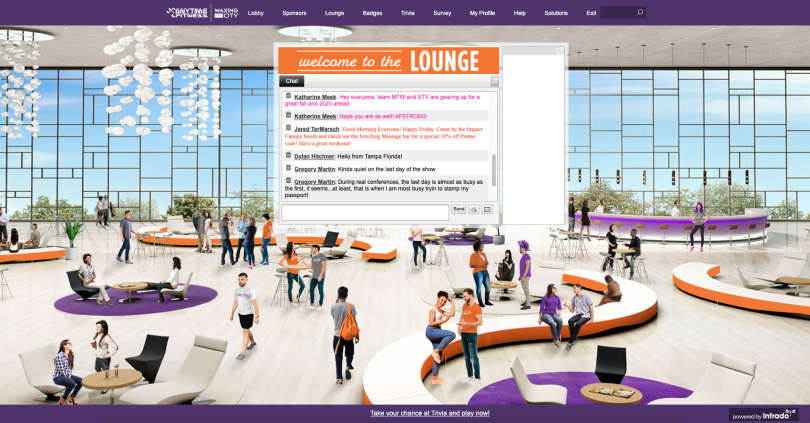
Schedule Events Strategically, and Think About Time Zones
While it can be tempting to jam the day full of speakers and activities, it’s necessary to space the content out just like at an in-person event, Chodor said.
People need to be able to take bathroom breaks, grab lunch or take care of their children. One way to approach that is to close the main sessions down for a few hours and open up a variety of breakout rooms. That way, people can take a break and choose where they want to go to get a different experience, Chodor said.
“Do things in three-hour blocks,” Chodor said. “If it’s a trade show, do sessions for a few hours, then have trade-show floor hours, one-on-one hours and ask-the-expert hours.”
It’s also important to recognize that people could be participating from anywhere. Unlike in-person events, there could be guests streaming from Japan, Germany, New York and California, all expecting the same conference experience.
“Do things in three-hour If it’s a trade show, do sessions for a few hours, then have trade-show floor hours, one-on-one hours and ask-the-expert hours.”
To navigate that issue, Chodor suggests recording a speaker session and re-airing it in different time zones, and then bringing people on for a live Q&A at the end. That way, someone in Los Angeles doesn’t need to get up at 6 a.m. to watch a 9 a.m. presentation in New York City to have a similar experience.

Incorporate the Virtual Into In-Person Strategy
As seamlessly as WiCyS’s networking event went, there’s one aspect Dohm couldn’t replicate, and it’s also the reason the organization isn’t considering going virtual for all events.
“All things considered, it was wonderful, but what was missing was the hugs,” Dohm said.
No matter how engaging a virtual event is, it’ll never be able to match the experience of bumping into a friend at a booth or having a face-to-face connection with a colleague. Chodor doesn’t think in-person events are going to go away. However, he does think people will be attending fewer of them.
“All things considered it was wonderful, but what was missing was the hugs.”
Bizzabo’s study found that 95 percent of respondents expect in-person events to be back, but they also expect the virtual experience to play a role in the future.
“We don’t see in-person events disappearing,” Alroy said. “But the majority of events will have a virtual component, which makes them hybrid events. It creates new revenue opportunities for people to join in remotely, but the experiences that can be created in person will not be fully replicable.”
While Alroy said hybrid strategies are still a work in progress, event organizers could look to the way that e-sports engage fans in person and via streaming as a solution.
“The key will be a technology that creates a deliberate rewarding and scalable experience for both in-person and virtual attendees,” Alroy said.
One way or another, it appears virtual events are here to stay.




